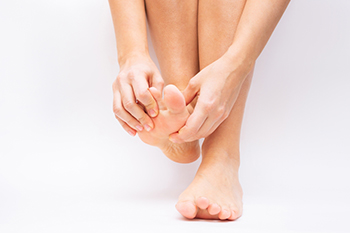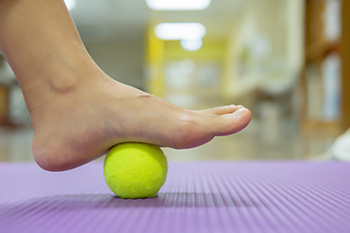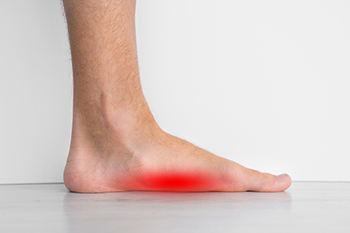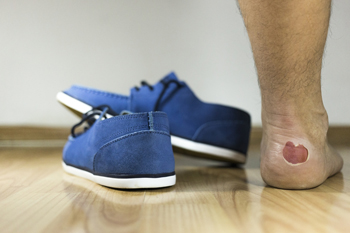

To many people, the toes might seem like small and insignificant parts of the human body. Nothing could be further from the truth. Although the toes are small, the function that they serve, not just for the feet but for the entire body, is monumental. The big toe, for instance, has an interesting biomechanical structure that benefits other parts of the body. Also known as the hallux, the big toe helps grip the ground to provide leverage during motion activities like walking and running. Additionally, the big toe helps the feet balance when an individual puts weight on their feet. Ultimately, the big toe is what helps keep an individual from falling anytime that they stand or engage in motion activities. Without the big toe, the foot would essentially have to relearn how to balance. This would force other parts of the foot to take on the balancing function that the big toe usually has. The big toe can be susceptible to a multitude of different afflictions and foot conditions, including gout, ingrown toenails, and sesamoiditis. It is therefore critical that one takes extra care of this body part to keep it from falling prey to any of these afflictions. If you want to learn more about the function of the big toe, contact a podiatrist.
If you have any concerns about your feet, contact Dr. Edward D. Hutson from Easton, PA. . Our doctor can provide the care you need to keep you pain-free and on your feet.
Biomechanics in Podiatry
Podiatric biomechanics is a particular sector of specialty podiatry with licensed practitioners who are trained to diagnose and treat conditions affecting the foot, ankle and lower leg. Biomechanics deals with the forces that act against the body, causing an interference with the biological structures. It focuses on the movement of the ankle, the foot and the forces that interact with them.
A History of Biomechanics
Modern technological improvements are based on past theories and therapeutic processes that provide a better understanding of podiatric concepts for biomechanics. Computers can provide accurate information about the forces and patterns of the feet and lower legs.
Understanding biomechanics of the feet can help improve and eliminate pain, stopping further stress to the foot.
If you have any questions please feel free to contact our offices located in Easton, and Northampton, PA . We offer the newest diagnostic and treatment technologies for all your foot and ankle needs.

The easiest way to strengthen the feet is by exercising. There are specific foot stretches and exercises that can enhance the overall foot when frequently practiced. The feet are the foundation of the body and are often forgotten about during strength training routines. There are two categories of muscles that are found in each foot. The muscles that are responsible for maintaining the arch and aid in shock absorption are referred to as the intrinsic foot muscles. The ankle is moved, and the toes are flexed and pointed by engaging the global lower limb muscles. The toes can be strengthened by performing toe curls which are done by stepping on a towel and picking it up with the toes. The arch can become stronger by sitting in a chair while trying to shorten the foot by bringing the ball of the foot toward the heel. If you would like additional information about the benefits of exercising your feet, please confer with a podiatrist.
Exercising your feet regularly with the proper foot wear is a great way to prevent injuries and build strength. If you have any concerns about your feet, contact Dr. Edward D. Hutson from Easton, PA. . Our doctor can provide the care you need to keep you pain-free and on your feet.
Exercise for Your Feet
Exercise for your feet can help you gain strength, mobility and flexibility in your feet. They say that strengthening your feet can be just as rewarding as strengthening another part of the body. Your feet are very important, and we often forget about them in our daily tasks. But it is because of our feet that are we able to get going and do what we need to. For those of us fortunate enough to not have any foot problems, it is an important gesture to take care of them to ensure good health in the long run.
Some foot health exercises can include ankle pumps, tip-toeing, toe rises, lifting off the floor doing reps and sets, and flexing the toes. It is best to speak with Our doctor to determine an appropriate regimen for your needs. Everyone’s needs and bodies are different, and the activities required to maintain strength in the feet vary from individual to individual.
Once you get into a routine of doing regular exercise, you may notice a difference in your feet and how strong they may become.
If you have any questions please feel free to contact our offices located in Easton, and Northampton, PA . We offer the newest diagnostic and treatment technologies for all your foot and ankle needs.

If you have ugly toenails, the cause might be toenail fungus. Many adults have it, particularly as one ages. This unsightly condition is especially common among those who go barefoot in public swimming areas, locker rooms, and who sweat inside their shoes for many hours in a day. The medical term for toenail fungus is onychomycosis. It is a condition that generally starts out as a white or yellow spot under the nail. While it is easy to ignore in the beginning stages, the toenail later begins to thicken, discolor, and crumble. The longer you wait to treat this, the longer it takes to get rid of it. The fungus that causes toenails to be affected is the same type of fungus that causes athlete’s foot. The two can happen concurrently if the fungus affects the skin around the infected nail. The toenail also may become painful and emit a foul odor. Those with diabetes or a suppressed immune system need to be especially cautious of toenail fungus because it can affect the blood circulation to the feet. If you suspect that you have toenail fungus, it is suggested that you see a podiatrist as soon as possible so that the condition can be treated before it spreads or becomes entrenched to the point of taking years to heal.
If left untreated, toenail fungus may spread to other toenails, skin, or even fingernails. If you suspect you have toenail fungus it is important to seek treatment right away. For more information about treatment, contact Dr. Edward D. Hutson of Easton, PA. . Our doctor can provide the care you need to keep you pain-free and on your feet.
Symptoms
Treatment
If self-care strategies and over-the-counter medications does not help your fungus, your podiatrist may give you a prescription drug instead. Even if you find relief from your toenail fungus symptoms, you may experience a repeat infection in the future.
Prevention
In order to prevent getting toenail fungus in the future, you should always make sure to wash your feet with soap and water. After washing, it is important to dry your feet thoroughly especially in between the toes. When trimming your toenails, be sure to trim straight across instead of in a rounded shape. It is crucial not to cover up discolored nails with nail polish because that will prevent your nail from being able to “breathe”.
In some cases, surgical procedure may be needed to remove the toenail fungus. Consult with your podiatrist about the best treatment options for your case of toenail fungus.
If you have any questions, please feel free to contact our offices located in Easton, and Northampton, PA . We offer the newest diagnostic and treatment technologies for all your foot care needs.

There are many kinds of foot conditions that may alter the natural structure of your feet. Flat feet are one such foot condition. Also known as fallen arches, flat feet are defined by the lack of a natural arch in the feet. Individuals with flat feet, for example, can stand upright on the ground with the sole of the foot pressing flush against the floor. Although flat feet are not typically considered a serious condition, they can make running and walking for extended periods more difficult. Some individuals are more apt to develop fallen arches. Infants are one commonly affected group, as their tendons and ligaments in the feet are not yet fully grown and tightened. However, by the age of two or three, fallen arches usually disappear. Another group is those who have muscle diseases. Individuals who suffer from cerebral palsy, for instance, might experience flat feet because of their muscle condition. Lastly, since flat feet can be caused by experiencing an injury to the foot, athletes and senior citizens who are prone to falling are also at risk of flat feet. If you fall into one of the aforementioned categories, contact a podiatrist to learn more about your susceptibility to flat feet.
Flatfoot is a condition many people suffer from. If you have flat feet, contact Dr. Edward D. Hutson from Easton, PA. . Our doctor will treat your foot and ankle needs.
What Are Flat Feet?
Flatfoot is a condition in which the arch of the foot is depressed and the sole of the foot is almost completely in contact with the ground. About 20-30% of the population generally has flat feet because their arches never formed during growth.
Conditions & Problems:
Having flat feet makes it difficult to run or walk because of the stress placed on the ankles.
Alignment – The general alignment of your legs can be disrupted, because the ankles move inward which can cause major discomfort.
Knees – If you have complications with your knees, flat feet can be a contributor to arthritis in that area.
Symptoms
Treatment
If you are experiencing pain and stress on the foot you may weaken the posterior tibial tendon, which runs around the inside of the ankle.
If you have any questions please feel free to contact our offices located in Easton, and Northampton, PA . We offer the newest diagnostic and treatment technologies for all your foot and ankle needs.

A blister on the foot often develops as a result of excess friction that can come from wearing shoes and socks that do not fit correctly. It is defined as a small area that resembles a bubble and is filled with a serum that contains antibodies. When a blister forms, it is the body’s natural defense technique in protecting the raw skin, and will gradually drain as new skin develops. Additional reasons a blister may form can include allergic reactions to an insect bite, or existing medical conditions that can consist of eczema and psoriasis. Many people have abnormal foot shapes which may affect the fit of the shoe, possibly leading to a blister forming. Patients who have peripheral neuropathy or diabetes may be unaware of a rubbing sensation on their feet as a result of the inability to feel pain. It is important to refrain from popping the blister, which may result in infection and damage to the raw skin underneath it. If you have a blister on your foot, please consult with a podiatrist who can help you to properly manage it, and guide you toward preventing future blisters from developing.
Blisters are prone to making everyday activities extremely uncomfortable. If your feet are hurting, contact Dr. Edward D. Hutson of Easton, PA. . Our doctor can provide the care you need to keep you pain-free and on your feet.
Foot Blisters
Foot blisters develop as a result of constantly wearing tight or ill-fitting footwear. This happens due to the constant rubbing from the shoe, which can often lead to pain.
What Are Foot Blisters?
A foot blister is a small fluid-filled pocket that forms on the upper-most layer of the skin. Blisters are filled with clear fluid and can lead to blood drainage or pus if the area becomes infected.
How Do Blisters Form?
Blisters on the feet are often the result of constant friction of skin and material, usually by shoe rubbing. Walking in sandals, boots, or shoes that don’t fit properly for long periods of time can result in a blister. Having consistent foot moisture and humidity can easily lead to blister formation.
Prevention & Treatment
It is important to properly care for the affected area in order to prevent infection and ease the pain. Do not lance the blister and use a Band-Aid to provide pain relief. Also, be sure to keep your feet dry and wear proper fitting shoes. If you see blood or pus in a blister, seek assistance from a podiatrist.
If you have any questions, please feel free to contact our offices located in Easton, and Northampton, PA . We offer the newest diagnostic and treatment technologies for all your foot care needs.